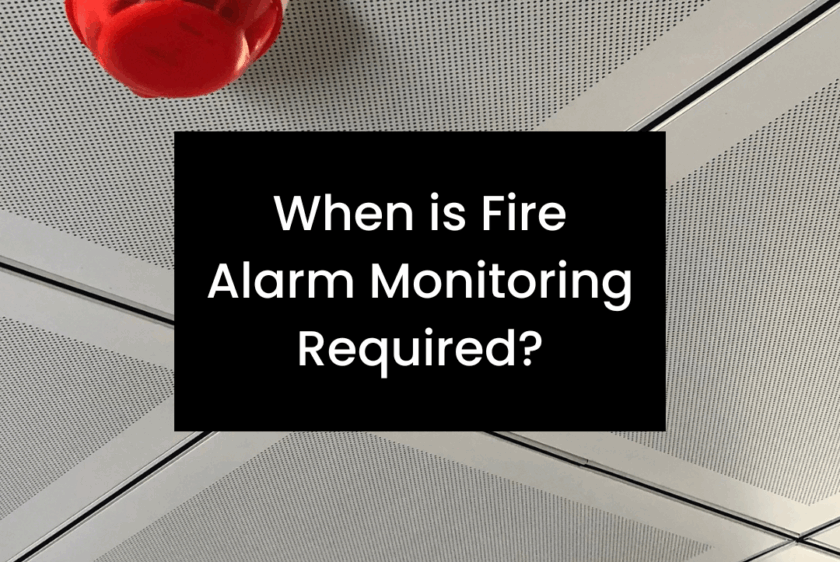If you own or manage a commercial property, you’ve likely asked: When is fire alarm monitoring required? The answer depends on several factors, including the type of building, local fire codes, and national standards such as NFPA 72.
In many cases, monitoring isn’t just a best practice—it’s a legal requirement.
Below, we break down when fire alarm monitoring is required, how to know if it applies to your facility, and what steps to take to stay compliant and protected.
What Is Fire Alarm Monitoring?
Fire alarm monitoring connects your fire alarm system to a professional off-site monitoring center. This ensures that if an alarm is triggered—whether by smoke, heat, or system fault—emergency services are automatically notified, even when no one is on site.
Local alarms (like sirens or strobes) may alert people inside the building, but monitored systems provide an added layer of safety by ensuring a rapid response from firefighters or emergency responders.
At DynaFire, we provide remote fire alarm monitoring through our proprietary DynaNet technology. Our wireless mesh system ensures fast, reliable, and future-proof communication, eliminating reliance on cellular networks.
When Is Fire Alarm Monitoring Required?
Fire alarm monitoring is typically required when your local authority having jurisdiction (AHJ), fire marshal, or national fire codes—like NFPA 72—mandate it. Here are the most common situations where fire alarm monitoring is required:
- Commercial buildings over a certain size or occupancy level
- Facilities with automatic fire sprinkler or suppression systems
- Multi-tenant buildings (like office parks, apartment complexes, or retail centers)
- Educational or healthcare institutions
- High-risk environments such as manufacturing facilities, laboratories, or storage sites
Even if your building isn’t explicitly required to have fire alarm monitoring, many insurance carriers and risk management teams strongly recommend it to protect assets and lives.
NFPA 72 and Fire Alarm Monitoring Requirements
NFPA 72, the National Fire Alarm and Signaling Code, outlines the national standards for fire alarm system installation and monitoring. According to this code:
- A UL-listed supervising station must monitor systems.
- Alarms must reach the monitoring center within 90 seconds.
- A backup communication path is required in case the primary fails.
DynaNet, our wireless mesh network, exceeds many of these standards by offering real-time communication without the risks and costs of traditional phone lines or cellular connections. That makes it an ideal choice for remote fire alarm monitoring.
What Happens If Monitoring Isn’t Installed When Required?
Neglecting to install monitoring when it’s required can result in serious consequences:
- Code violations or failed fire inspections
- Delays in occupancy permits or business licenses
- Increased liability and insurance issues in the event of a fire
- Greater risk to people and property
Most importantly, a lack of monitoring can delay emergency response, giving a fire more time to spread, leading to higher costs and greater danger.
Does My Building Need Fire Alarm Monitoring?
Not every building requires monitoring, but many do. The best way to find out is to:
- Check your local fire code or building code.
- Consult your AHJ or fire marshal.
- Work with a licensed fire protection company like DynaFire.
Our experts stay current on Florida codes and local inspection requirements. We can assess your property and determine if monitoring is required or recommended based on your risk profile.
Choose DynaFire for Reliable Fire Alarm Monitoring
DynaFire’s remote fire alarm monitoring uses DynaNet, a wireless mesh monitoring system that eliminates the need for cellular or phone lines. You won’t have to worry about service outages, cellular upgrades, or compatibility issues. Plus, you get:
- 24/7 UL-listed monitoring
- Immediate emergency alerts and notifications
- Code-compliant reporting and backup systems
- Scalable solutions for facilities of all sizes
Whether you’re building a new system or updating an existing one, DynaFire delivers the expertise and technology to keep your business safe, compliant, and protected—now and in the future.
Ready to find out if your facility needs monitoring? Contact us today to schedule a consultation or learn more about DynaNet.






